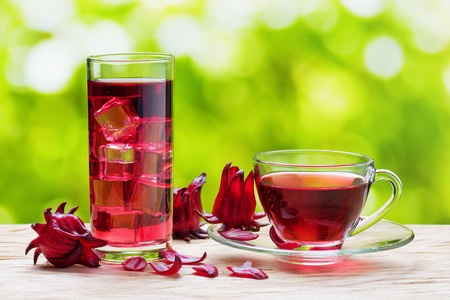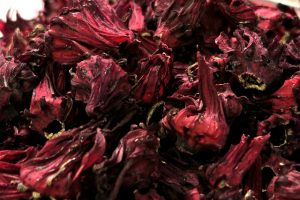
Hibiscus sabdarrifa or roselle to give it its other commonly used name is a plant ingredient to watch for in 2018. We have however been drinking the tea made from the hibiscus calyces or flower heads for centuries. We’ve also been making full use of its health benefits and properties too to help us deal with hypertension or high blood pressure, inflammation, improve our immunity and even manage diabetes. There really is plenty to recommend it !
The hibiscus flower is probably a breath of the tropics for many shivering at home. The plant is native to both tropical and sub-tropical regions of the world. Its many relatives are grown as much for decoration as anything else. The one species we are interested in is Hibiscus sabdariffa (L.). It is also known as the Jamaica flower. There are 300 species in the family called Malvaceae. We are familiar with vegetables such as Ladies Fingers for example which come from the same genus.
The flower itself is edible but it is the calyx which is the portion that protects the petals before they flower which is used for making tea, soft drink beverages and other foodstuffs. The calyx is full of organic acids so any beverages made from the calyx tend to have a slightly sour flavour. That explains why it is known as ‘sour tea’ in some quarters. The tea is known around the world and you might hear it called agua de Jamaica in some Spanish speaking latin countries. The plant is grown, not just for its ingredients but as a source of fibre. It grows very easily and is used as part of a multi-cropping system. the Chinese are using the seeds to produce a food-grade oil. In West Africa such as Nigeria, the leaves are pounded with the seeds for use in various meals.
Traditional Culinary Uses
The fresh or dried calyces of H. sabdariffa is sued to prepare teas, beverages (hot and cold), herbal drinks, fermented to make a type of wine, sweet jam, candies, confectionary, chutney and as a replacement for cranberry in savoury sauces. we’ve seen it in ice-cream, jellied confectionary, chocolates, flavouring agents, cakes, desserts and puddings. Essentially, the calyx has many valuable uses.
In Egypt, the calyces are used to make ‘cacody’ tea and fermented beverages. In the Sudan and Nigeria, the calyces are boiled with sugar to produce the drink called ‘Karkade’ or ‘Zoborodo’. In Mexico, they make something called ‘Jamica’, ‘‘agua de Jamaica’’ or ‘‘té de Jamaica’’.
The flower can be candied by the way and used on cakes, especially wedding cakes. It has also been baked with.

Components
Sour tea contains many chemical constituents including alkaloids, l-ascorbic acid (vitamin C), anisaldehyde, anthocyanins including cyanidin-3 rutinoside, delphinidin-3-sambubioside, cyanidin-3-sambubioside and other delphinidins, ß-carotene, ß-sitosterol, citric acid, malic acid, hydroxycitric acid, galactose, gossypetin, hibiscetin, mucopolysaccharide, pectin, protocatechuic acid, polysaccharide, quercetin, stearic acid, and various waxes.
More in-depth studies are being undertaken of various cultivars and national varieties of the plant. For example, Mexican Hibiscus cultivars with different coloured calyces from green and yellow through to red have been examined (Borras-Linares et al., 2015).
The anti-bacterial effects have been assessed and the ethanolic extracts are effective against Gram-negative (Escherichia coli, Salmonella enteritidis) and Gram-positive (Staphylococcus aureus, Micrococcus luteus) microorganisms (Borras-Linares et al., 2015).
Health Benefits Of Hibiscus sabdarrifa
Hibiscus or sour tea has created plenty of excitement over the years. There are many reviews describing the pharmacological benefits of the plant (Da Costa Rocha et al., 2014). The antioxidant benefits are linked to inhibition of enzymes such as α-glucosidase and α-amylase, inhibition of angiotensin-converting enzymes (ACE), and direct vaso-relaxant effects or calcium channel modulation. Many of the clinical studies have been reviewed where treatment for hypertension (blood pressure) or reduction of blood lipid levels are concerned (Hopkins et al., 2013).
Cancer Benefits From Hibiscus sabdarrifa
Hibiscus tea contains a compound called protocatechuic acid which in cancer cell experiments has anti-tumour and antioxidant properties. Whilst this compound is found in other plants, there can be no doubt that Hibiscus is capable of slowing the growth of cancerous cells. It appears to induce a biochemical process called apoptosis which is programmed cell death.
Reducing Hypertension and Blood Pressure
Hibiscus tea was shown in a study to help lower blood pressure or hypertension, especially in people with a pre-hypertension or mild hypertensive state. Given that in the USA, about 1/3rd of the adult population deals with high blood pressure, any product that alleviates the situation is helpful. Whilst there is often difficulty comparing sour tea with black tea in various studies because they taste so different, it has been possible to identify a marked benefit for hibiscus over black tea in reducing hypertension (Wahabi et al., 2010).
Diabetes And Hibiscus sabdarrifa
Diabetics often have to deal with high triglyceride and lipid levels in their blood stream. Hibiscus tea has been known for many years through its traditional uses to reduce both the blood glucose and lipid levels. In medical terms this is a hypoglycaemic and hypolipidaemic effect.
A study with 53 patients who suffered from type-2 diabetes were given either sour tea or black tea to drink twice a day for a month (Mozaffari-Khosravi et al., 2009a). This was a classic sequential randomized controlled clinical trial. The study showed that the hibiscus tea (sour tea) modified their blood lipid profile more effectively than the black tea.
Those studies have extended to assessing the benefits on patients with Metabolic Syndrome (Gurrola-Diaz et al., 2010).
Obesity
Obesity is a major blight on many people’s health. There is some evidence that certain conditions associated with high visceral fat can be overcome with Hibiscus extracts. Indeed, there is a some evidence to suggest that a roselle extract could prevent fat deposition and reduce the impact of fat accumulating around the liver (Chang et al., 2014).
Inflammation
Various anthocyanins in roselle extracts have been found to inhibit enzymes associated with causing inflammation. These are various cyclooxygenases (Christian et al., 2006).
References
Borrás-Linares, I., Fernández-Arroyo, S., Arráez-Roman, D., Palmeros-Suárez, P. A., Del Val-Díaz, R., Andrade-Gonzáles, I., … & Segura-Carretero, A. (2015). Characterization of phenolic compounds, anthocyanidin, antioxidant and antimicrobial activity of 25 varieties of Mexican Roselle (Hibiscus sabdariffa). Industrial Crops and Products, 69, pp. 385-394. https://doi.org/10.1016/j.indcrop.2015.02.053
Chang, H. C., Peng, C. H., Yeh, D. M., Kao, E. S., & Wang, C. J. (2014). Hibiscus sabdariffa extract inhibits obesity and fat accumulation, and improves liver steatosis in humans. Food Function, 5(4), pp. 734–739
Christian, K. R., Nair, M. G., & Jackson, J. C. (2006). Antioxidant and cyclooxygenase inhibitory activity of sorrel (Hibiscus sabdariffa). Journal of Food Composition and Analysis, 19(8), pp. 778–783.
Da-Costa-Rocha, I., Bonnlaender, B., Sievers, H., Pischel, I., & Heinrich, M. (2014). Hibiscus sabdariffa L.–A phytochemical and pharmacological review. Food Chemistry, 165, pp. 424-443
Hopkins, A. L., Lamm, M. G., Funk, J. L., & Ritenbaugh, C. (2013). Hibiscus sabdariffa L. in the treatment of hypertension and hyperlipidemia: a comprehensive review of animal and human studies. Fitoterapia, 85, pp. 84-94.
Gurrola-Díaz, C. M., García-López, P. M., Sánchez-Enríquez, S., Troyo-Sanromán, R., Andrade-González, I., & Gómez-Leyva, J. F. (2010). Effects of Hibiscus sabdariffa extract powder and preventive treatment (diet) on the lipid profiles of patients with metabolic syndrome (MeSy). Phytomedicine, 17(7), pp. 500-505.
Mozaffari-Khosravi, H., Ahadi, Z., & Tafti, M. F. (2014). The effect of green tea versus sour tea on insulin resistance, lipids profiles and oxidative stress in patients with type 2 diabetes mellitus: A randomized clinical trial. Iranian Journal of Medical Sciences, 39(5), pp. 424.
Mozaffari-Khosravi, H., Jalali-Khanabadi, B. A., Afkhami-Ardekani, M., & Fatehi, F. (2009a). Effects of sour tea (Hibiscus sabdariffa) on lipid profile and lipoproteins in patients with type II diabetes. The Journal of Alternative and Complementary Medicine, 15(8), pp. 899-903. doi: 10.1089/acm.2008.0540 https://www.ncbi.nlm.nih.gov/pubmed/19678781
Mozaffari-Khosravi, H., Jalali-Khanabadi, B. A., Afkhami-Ardekani, M., Fatehi, F., & Noori-Shadkam, M. (2009b). The effects of sour tea (Hibiscus sabdariffa) on hypertension in patients with type II diabetes. Journal of Human Hypertension. 23(1), pp. 48-54
Wahabi, H. A., Alansary, L. A., Al-Sabban, A. H., & Glasziuo, P. (2010). The effectiveness of Hibiscus sabdariffa in the treatment of hypertension: a systematic review. Phytomedicine, 17(2), pp. 83-86
Zhen, J., Villani, T. S., Guo, Y., Qi, Y., Chin, K., Pan, M. H., … & Wu, Q. (2016). Phytochemistry, antioxidant capacity, total phenolic content and anti-inflammatory activity of Hibiscus sabdariffa leaves. Food Chemistry, 190, pp. 673-680


Leave a Reply